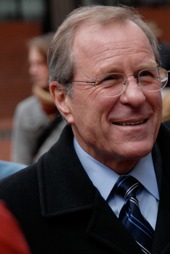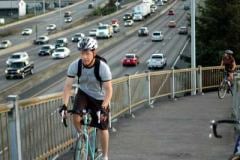
[Editor’s note: This is the first article in our new section, BikePortland.org: In-Depth.
The main contributor to this section will be Libby Tucker. Ms. Tucker is a freelance reporter whose articles have been published in a myriad of outlets including the Associated Press, MSNBC.com, The Oregonian, and others. She was most recently a staff writer for the Daily Journal of Commerce where she covered transportation, construction and energy. She is also the author of the blog, Naked Energy.
In this article, Ms. Tucker takes a closer look at how bikes figure into Governor Kulongoski’s 2009 plans.]
Hey Governor, what about bikes?
Bike advocates look for hidden benefits of Kulongoski’s proposed transportation package for 2009

Courthouse Square in April.
(Photos © J. Maus)
Even as Oregon lawmakers consider ways to lower greenhouse gas emissions and slash the state budget, Gov. Ted Kulongoski’s proposed Jobs and Transportation Act of 2009 lacks any significant new policies for bikes — the greenest, most cost-effective way to get around (especially in cities).
The word “bicycle” is mostly absent from the document, which proposes a 2-cent gas tax increase and new fees to raise another $499 million for the state highway fund. Also missing is a visionary plan to encourage cycling on the order of the proposed new $5,000 state income tax credit toward the purchase of plug-in hybrid and all-electric cars.
“The word “bicycle” is mostly absent from the document…Also missing is a visionary plan to encourage cycling.”
Instead, the $1 billion package tags $600 million in bond sales for projects that unclog freight traffic; $150 million every two years *in one-time money (that will be generated by lottery bond proceeds) for rail, aviation, transit and marine projects; $35 million toward a new Amtrak train; $6.5 million a year for cash-strapped county maintenance programs; $5 million every two years for elderly and disabled services; and a range of other proposals that attempt to make driving greener and cut congestion.
[*Update 12/5; Please note our correction in the paragraph above regarding the $150 multimodal transportation investment.]
“There’s some creative accounting, a little more money, but there’s nothing new yet (for non-auto modes),” said Rex Burkholder, a Metro councilor who helped advise the governor’s policy as a member of the transportation visioning committee.
Kulongoski’s proposal isn’t anti-bike, however, advocates and transportation planners say. Hidden programs are stashed throughout the plan that direct more state dollars to new bike projects.
For starters, the Oregon bike bill, passed in 1971, requires 1 percent of the proposed highway fund increase to be spent on bicycle and pedestrian improvements. That amounts to a $4.9 million increase in spending, or nearly 80 percent more than current state spending on bike and pedestrian improvements.

Bridge near downtown Portland.
“It’s never enough but what is being proposed is a substantial increase over what we’ve seen in the past,” said Karl Rohde, a lobbyist for the Bicycle Transportation Alliance. “We have to work really hard to constantly put the pressure on to make sure it happens.”
Without Kulongoski’s bill, the Oregon Department of Transportation estimates it will spend between $6.1 million to $6.2 million of its roughly $640 million a year highway fund revenue on bicycle and pedestrian projects each year from 2009 to 2011, as a result of the 1-percent requirement, or about the same amount the agency spends re-painting pavement markings.
From 2001 to 2005, the state failed to spend even 1 percent of highway funds on bike and pedestrian projects, according to ODOT’s 2007 bicycle and pedestrian program annual report.
Boosting the highway fund by $499 million affords bike advocates an opportunity to push for non-traditional improvements, such as bike signals and physically dividing lanes to split bike and car traffic, says Mia Birk, a transportation consultant with Alta Planning and Design.
< ?php if (function_exists('dfrad')) { echo dfrad('ad_225x225'); } ?>
“By being the eyes of the community you ensure the appropriate bikeway treatment, and that might be pushing for facilities that are way beyond what transportation officials want to do,” said Birk.
The proposal also mentions an “expanded” Transportation Options Program that includes bike and pedestrian programs, carpools and vanpools, ridesharing, and education and marketing to reduce the number of cars on the road. Specific dollar amounts for the expansion haven’t yet been drafted, however.
And as the 2009 session begins Kulongoski will likely propose an amendment to the bike bill that would increase the requirement to 1.5 percent of state highway funds towards bike and pedestrian improvements, said Hans Bernard, Kulongoski’s deputy legislative director and former transportation advisor.
All told, the package could increase highway fund spending on bike and pedestrian projects from about $6.2 million to $13.7 million a year.
“Cycling is the cheapest option we have for reducing VMT and we consistently pass over it to look at the sexier things.”
— transportation activist Chris Smith
“The governor recognizes the transportation package needs to benefit all modes and increasing bicycle mode share is a key component of that proposal,” said Bernard.
Benefits for state and local bicycle and pedestrian projects are also hidden within broader categories of the proposal. Requirements for least-cost planning and targets for vehicle miles traveled (VMT) are designed to favor walking and biking without necessarily labeling them as such, said Burkholder.
The least-cost approach to transportation planning, for example, counts carbon dioxide emissions as a cost and would therefore direct state and regional planners to invest first in bike and pedestrian projects, which carry the lowest carbon footprint.
“Event though it’s kind of buried in line items, the end result is more funding in bike and ped,” said Sheila Lyons, pedestrian and bicycle program manager for ODOT. “There’s probably plenty of money; that’s where least-cost planning could have some real exciting implications. My sincere hope is that means bikes and walking do rise to the top.”
Despite their general support for the transportation package, cycling advocates and planners remain quietly frustrated the proposal doesn’t include a bigger vision, however, especially more funding for bike projects and policies.
“Cycling is the cheapest option we have for reducing VMT and we consistently pass over it to look at the sexier things,” says Chris Smith, a Portland transportation advocate and former city council candidate. “It’s disappointing it’s not being pointed out as a policy. The governor needs to talk about it as a strategy and have some dedicated line items to address as opposed to letting funding (for bike projects) be pulled out of different pots.”
Stay tuned for more BikePortland In-Depth stories from Libby and other contributors in the weeks to come. Next up will be a closer look at the contrast of enthusiasm between bikes and Oregon’s dreams for electric cars.
Let us know what you think about this new offering. — Jonathan

